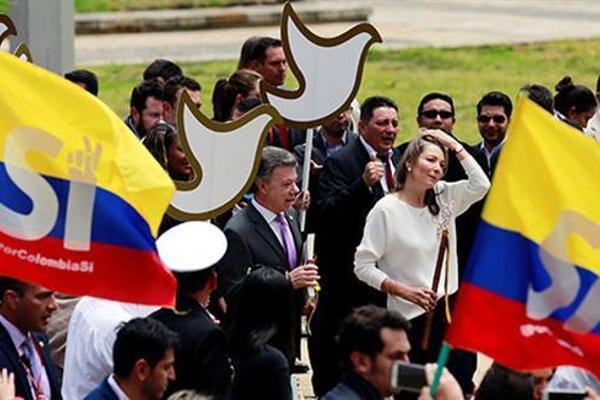Colombia ceasefire ends half-century war with FARC
BOGOTA – Agence France-Presse


Colombia's President Juan Manuel Santos (L) and Colombian First Lady Maria Clemencia de Santos arrives at congress to present the FARC peace accord to the Colombian Congress in Bogota, Colombia, August 25, 2016. REUTERS photo
Colombia began on Aug. 29 its first day of peace with the country’s largest insurgency after a ceasefire between the FARC and the government went into effect, ending 52 years of warfare.The full ceasefire ordered by President Juan Manuel Santos and the head of the Revolutionary Armed Forces of Colombia (FARC), Timoleon Jimenez, began at midnight by local time on Aug. 28.
“This August 29 a new phase of history begins for Colombia. We silenced the guns. THE WAR WITH THE FARC IS OVER!” Santos wrote on Twitter one minute after midnight.
A message from the official FARC account at the same time was more restrained: “From this moment on the bilateral and definitive ceasefire begins.”
In a declaration to reporters in Cuba, where peace talks were held, Jimenez said that he ordered all commanders and units, “and each one of our combatants to definitively cease fire and hostilities against the Colombian state” starting at midnight.
Santos ordered the Colombian armed forces on Aug. 26 to halt anti-FARC operations at midnight on Aug. 28.
The ceasefire is the first in which both sides are committed to a definite end to the fighting.
“The ceasefire is really one more seal on the end of the conflict. It is the test of fire,” said Carlos Alfonso Velazquez, a security expert at the University of La Sabana.
Hundreds of thousands of Colombians have died since 1964 as rebel armies and gangs battled in the jungles in what is considered Latin America’s last major civil armed conflict.
Santos and Jimenez are due to sign a final, full peace agreement sometime between September 20 and 26.
The end of hostilities will be followed by a six-month demobilization process.
Starting from Aug. 29, the FARC’s estimated 7,500 fighters will head to collection points to surrender their weapons under U.N. supervision.
Guerrillas who refuse to demobilize and disarm “will be pursued with all the strength of the state forces,” Santos told El Espectador newspaper.
Before the demobilization, the FARC will convene its leaders and troops one last time before transforming into “a legal political movement,” according to a statement published on Aug. 28.
On October 2, Colombians will vote in a referendum that Santos hopes will endorse the peace agreement.
“A victory for the ‘Yes’ vote will be a mandate from citizens for future governments,” Santos was quoting as saying by El Espectador.
“The plebiscite will grant the political legitimacy that is needed.”
He said the exact question that will be put to voters in the referendum would be announced “in the coming days.”
“We are on the verge of perhaps the most important political decision of our lives,” Santos said in a speech on Aug. 28.
The territorial and ideological conflict has drawn in various left- and right-wing armed groups and gangs.
It has left some 260,000 dead, 45,000 missing and 6.9 million people uprooted from their homes.
Efforts to launch peace talks with a smaller rebel group, the National Liberation Army, have yet to bear fruit.
But with the FARC ordering a ceasefire the conflict appears to be reaching an end.
“To the soldiers, naval personnel and air force pilots, police and state security and intelligence agencies, we wish to express our clear and definite will for reconciliation,” said Jimenez, known by the nom-de-guerre Timochenko, in Havana.
“Rivalries and resentment must remain in the past. Today more than ever we regret that so much death and pain has been caused by the war. Today more than ever we wish to embrace them as compatriots and start to work together for a new Colombia.”
